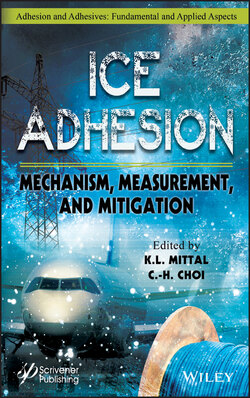Читать книгу Ice Adhesion - Группа авторов - Страница 35
2.2.1.1 Homogeneous Nucleation of Water Droplets and Ice from Vapor
ОглавлениеHomogeneous nucleation of water droplets in supersaturated vapor may be the most fundamental example. The pre-exponential factor in the rate equation for homogeneous nucleation of water was developed by Becker and Doring in 1935 [4] as
using csat,w = psat,w/kBT, in Eq. 2.7, where σv,w is the surface free energy between vapor and water, is the molecular mass of water and pis the actual vapor pressure.
v As indicated in Eqs. 2.3 to 2.6, J is very sensitive to the supersaturation since the exponential term varies with S-2. This result is clearly revealed by the numerical evaluation of homogeneous nucleation rate J for droplets in water vapor (see Rows 1 and 2 in Table 2.1 [7]). For the nucleation of water vapor at –12°C, J (water) increases 5 orders of magnitude as Sv,w increases from 5 to 6. The ascending nucleation rate indicates a critical supersaturation Sv,w(cr) at which the droplets suddenly emerge from the water vapor. From an experimental point of view, Sv,w(cr) are normally defined to correspond to J = 1 cm-3 sec-1 in most instances. Considering that the required critical supersaturation is extremely high, the homogeneous nucleation of water droplets can only be realized under laboratory conditions and does not occur in the atmosphere.
Table 2.1 Variation of the nucleation rate J as a function of supersaturation S over water Sv,w and over ice Sv,i for homogeneous nucleation of droplets and ice in water vapor at –12°C [7].
| S v,w | 2 | 3 | 4 | 5 | 6 |
| J (water)/cm-3 sec-1 | 1.9 × 10-112 | 7.0 × 10-31 | 1.1 × 10-10 | 7.1 × 10-2 | 6.0 × 103 |
| S v,i | 2.249 | 3.374 | 4.499 | 5.623 | 6.748 |
| J (ice)/cm-3 sec-1 | 1.9 × 10-112 | 1.9 × 10-112 | 1.9 × 10-112 | 1.9 × 10-112 | 3.4 × 10-52 |
Eq. 2.8 also holds for the nucleation rate of spherical ice nucleus from vapor by replacing csat,w, Sv,w, ρw, σv,w with csat,i, Sv,i, ρi, σv,i. It is important to note that since ∆G*∝ σ3 and σv,w < σv,i, the nucleation barrier ∆G* of ice crystals is larger than that of water droplets under an identical pressure of water vapor. In consequence, for a given supersaturation of vapor over liquid water, Jice ≪ Jwater although the corresponding supersaturation of vapor over ice Sv,i is relatively higher. This is reflected by the values in Rows 3 and 4 of Table 2.1, where at the same water vapor pressure, ice nucleation rates are negligible compared to water nucleation rates. This prediction is also in agreement with Ostwald’s step rule (Ostwaldsche Stufenregel) [8], which states that the supersaturated water vapor will not directly transition to the most stable phase (ice), but rather to the metastable state (supercooled water) first. It has been proved that for temperature greater than –100°C, Ostwald’s rule is always applicable for the homogeneous nucleation of water [92]. If nucleation is heterogeneous, the situation will be more complicated and a detailed discussion will be presented in Chapter 3.
